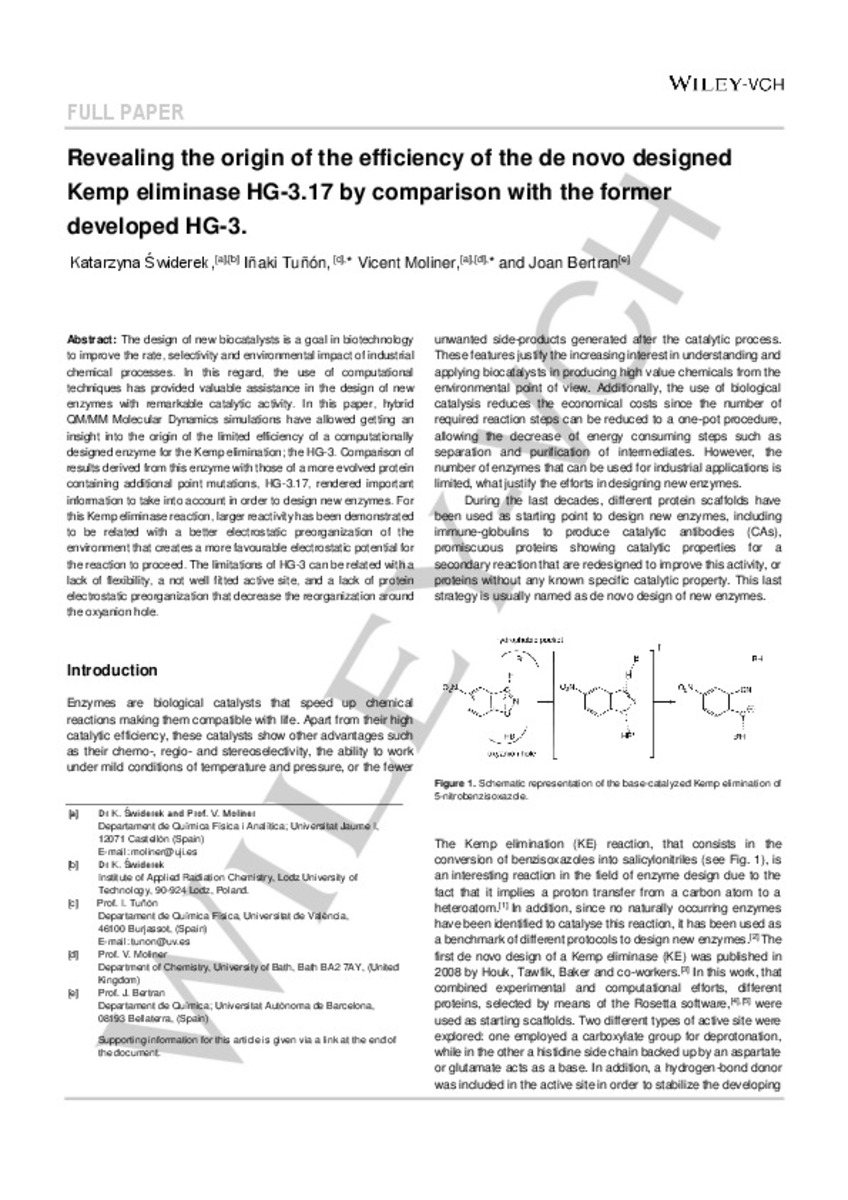Mostrar el registro sencillo del ítem
Revealing the Origin of the Efficiency of the De Novo Designed Kemp Eliminase HG-3.17 by Comparison with the Former Developed HG-3
| dc.contributor.author | Świderek, Katarzyna | |
| dc.contributor.author | Tuñón, Iñaki | |
| dc.contributor.author | Moliner, Vicent | |
| dc.contributor.author | Bertrán, Juan | |
| dc.date.accessioned | 2017-12-15T11:32:05Z | |
| dc.date.accessioned | 2018-05 | |
| dc.date.available | 2017-12-15T11:32:05Z | |
| dc.date.available | 2018-05 | |
| dc.date.issued | 2017-05 | |
| dc.identifier.citation | ŚWIDEREK, Katarzyna, et al. Revealing the Origin of the Efficiency of the De Novo Designed Kemp Eliminase HG‐3.17 by Comparison with the Former Developed HG‐3. Chemistry-A European Journal, 2017, vol. 23, no 31, p. 7582-7589. | ca_CA |
| dc.identifier.uri | http://hdl.handle.net/10234/171022 | |
| dc.description.abstract | The design of new biocatalysts is a goal in biotechnology to improve the rate, selectivity and environmental impact of industrial chemical processes. In this regard, the use of computational techniques has provided valuable assistance in the design of new enzymes with remarkable catalytic activity. In this paper, hybrid QM/MM molecular dynamics simulations have allowed insights to be gained on the origin of the limited efficiency of a computationally designed enzyme for the Kemp elimination; the HG-3. Comparison of results derived from this enzyme with those of a more evolved protein containing additional point mutations, HG-3.17, rendered important information that should be taken into account in the design of new enzymes. For this Kemp eliminase reaction, higher reactivity has been demonstrated to be related to a better electrostatic preorganisation of an environment that creates a more favourable electrostatic potential for the reaction to proceed. The limitations of HG-3 can be related to a lack of flexibility, a not well-fitted active site, and a lack of protein electrostatic preorganisation, which decrease the reorganisation around the oxyanion hole. | ca_CA |
| dc.format.extent | 7 p. | ca_CA |
| dc.format.mimetype | application/pdf | ca_CA |
| dc.language.iso | eng | ca_CA |
| dc.publisher | Wiley | ca_CA |
| dc.rights | Copyright © 2017 John Wiley & Sons, Inc. All Rights Reserved | ca_CA |
| dc.rights.uri | http://rightsstatements.org/vocab/InC/1.0/ | * |
| dc.subject | biocatalysts | ca_CA |
| dc.subject | density functional calculations | ca_CA |
| dc.subject | enzyme catalysis | ca_CA |
| dc.subject | enzyme models | ca_CA |
| dc.subject | noncovalent interactions | ca_CA |
| dc.subject | protein engineering | ca_CA |
| dc.title | Revealing the Origin of the Efficiency of the De Novo Designed Kemp Eliminase HG-3.17 by Comparison with the Former Developed HG-3 | ca_CA |
| dc.type | info:eu-repo/semantics/article | ca_CA |
| dc.identifier.doi | http://dx.doi.org/0.1002/chem.201700807 | |
| dc.relation.projectID | Spanish Ministerio de Economía y Competitividad (project CTQ2015-66223-C2) ; Universitat Jaume I (project P1⋅1B2014-26) ; Generalitat Valenciana (PROMETEOII/2014/022) ; Polish Ministry of Science and Higher Education (“Iuventus Plus” program project no. 0478/IP3/2015/73, 2015–2016) | ca_CA |
| dc.rights.accessRights | info:eu-repo/semantics/openAccess | ca_CA |
| dc.relation.publisherVersion | http://onlinelibrary.wiley.com/doi/10.1002/chem.201700807/full | ca_CA |
| dc.type.version | info:eu-repo/semantics/draft | ca_CA |
| dc.type.version | info:eu-repo/semantics/acceptedVersion | ca_CA |
Ficheros en el ítem
Este ítem aparece en la(s) siguiente(s) colección(ones)
-
QFA_Articles [813]
Articles de publicacions periòdiques








